Russ Henneberry
Russ Henneberry is the Director of Editorial at DigitalMarketer and co-author of Digital Marketing for Dummies. In his time at DigitalMarketer, front end traffic to DigitalMarketer content has increased by 1125%. The content marketing team, under Russ’s management, generates 1000’s of leads and sales per month by developing and executing a truly “full funnel” content strategy.
Alright. So, I’m pumped. I’m going to teach you what I’ve learned by working at a company who makes its money selling information products. My name’s Russ Henneberry, DigitalMarketer’s Editorial Director, and I’ve been doing this since Clinton was in office.
I’ve been doing the information product thing since rapper Coolio did a stage dive, apparently, and no one caught the man. And instead, they beat him up and stole his shoes. That apparently happened in 2009. I actually Googled crazy things that happened in 2009. Apparently Coolio, they stole his shoes.
Here’s my promise to you today. You’re going to learn to sell things like courses and trainings, you’re going to learn to sell things like digital and physical books, membership sites. Live coaching, training and consulting also fits in here very, very well. And, really any service, because what we’re going to learn about today is the five laws of selling information products, and the first one is called the law of the unknown.
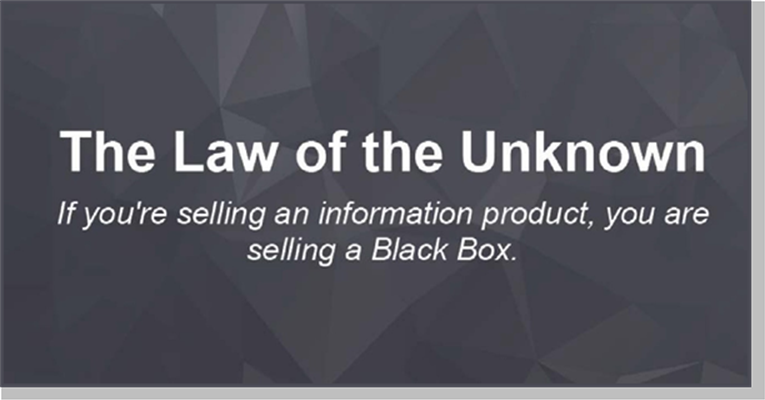
If you’re selling an information product, you’re actually selling a black box. So, picture yourself, you set up in a store, and you put out your table, and you’re going to sell some stuff. So you put your for sale sign on there, and you set your product out there. And it’s an information product. This is actually what your product looks like to them. It’s a black box. They can’t see it, they can’t touch it, they can’t smell it or kick it or try it on or do any of those things. You’re selling air, basically.
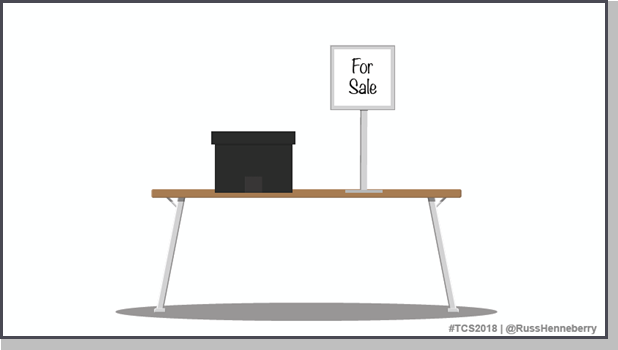
So, selling black boxes is tough. I mean, your prospects are either going to
react a little bit confused or a little bit angry.
You go up to somebody and say, “Hey, I want you to give me $295.” They’ll say, “For what?” And it’s like, this black box? I want you to buy this black box. Well, they’re either going to bite, or they’re going to disappear on you unless you know these five laws.
It’s tough to sell information. When you go through these five things, I’m not going to teach you how to sell today. I’m going to teach you the five things you gotta know about selling to work out in an information product business. If you don’t follow these five things, it’s really difficult.
So, with these five laws, you can actually make a lot of money selling information. We sell millions of dollars worth of information products every year, and the first law is the law of offers.

The law of offers says that the number one factor in selling a black box to someone is the offer.
So, if your information product is not selling, if you can’t sell your training, your course, or your membership site, the product may not be the problem. It’s probably not the product. Oh, this is where I do my disclaimer that we assume that you are creating good stuff, alright? If you’re creating
great stuff, the product’s probably not the problem. It’s more likely the offer you’re making.
If you only learn one thing from this today it’s that products aren’t offers.
A product and an offer are very, very different things. So for example, this is not an offer:
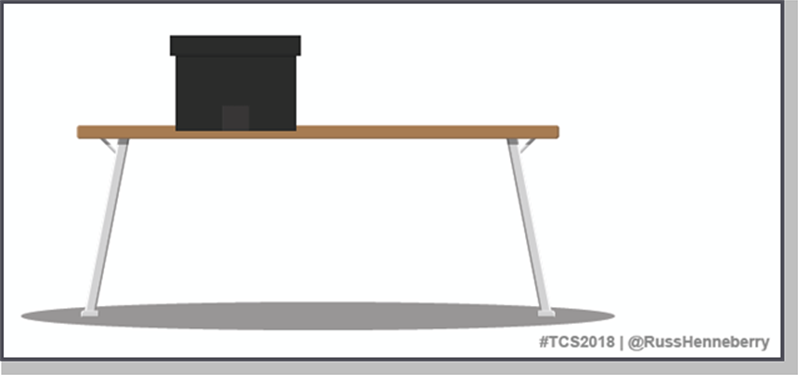
That’s a black box sitting on a table. This isn’t an offer either:
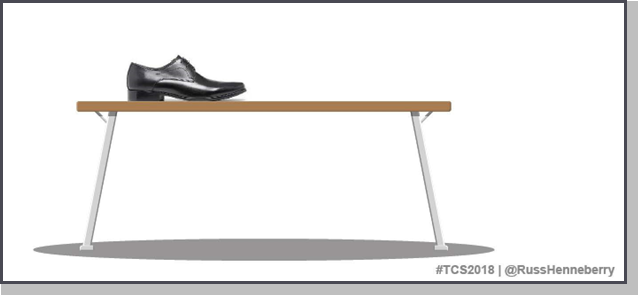
It’s not an offer, it’s a shoe. It’s a product. And so you need to understand the difference between a product and an offer.
If you add a price to this product, you now have an offer. Those are some expensive shoes. But, that’s an offer. Buy these shoes for $299. That’s an offer.

If I sell this black box for $795, now I have an offer. So, I had a product only, it was a black box, now I have a price tag on it, it’s now $795, that’s an offer. Now, it’s not a compelling offer. Buy this black box, $795. It’s a pretty crappy offer, but it’s an offer.
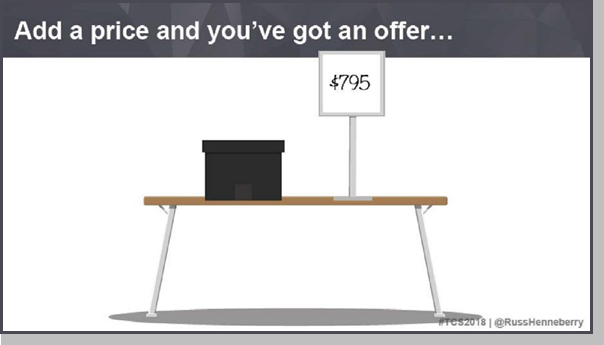

How can you make that offer more compelling? I’ll give you seven ways to structure your offers, and please don’t think that this is all overly obvious, because so many people get this wrong.
So many people don’t understand that, if you tweak an offer, sometimes you can revive a dead product. A product that’s not selling at DigitalMarketer will not be killed until it has been tried in a few different methods. A few different offers are made.
So here are 7 different ways you can structure an offer, more than just saying, well, here’s a thing, here’s my widget, here’s the price:
- Add payment terms
- Bundle it
- Offering a trial
- Buy one, get one free
- Premium offer
- Flash sale offer
- Contribute to a cause
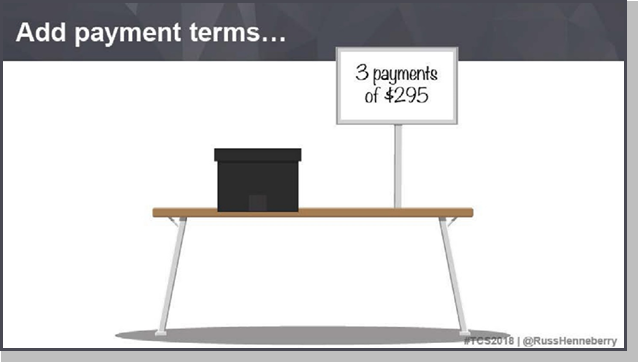
Three payments of $295, that’s different, isn’t it, from one payment of $795? So, if you’ve got a single product, you make a single offer, and you’re like, “Well, it doesn’t work. They don’t like the product. I suck.” That may not be the case. Try some of these things…
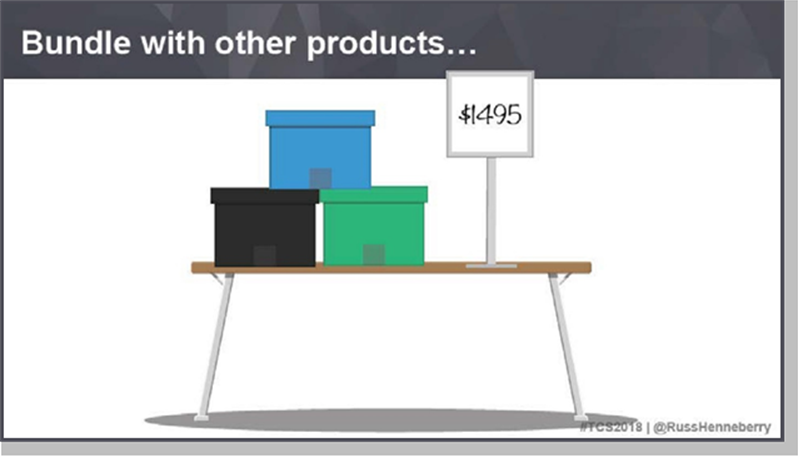
The second one is bundle it. Bundle with other products. So, don’t just sell them a black box, sell them a black box and a green box. Sell them a black box, and a green box, and a blue box all for $1495.
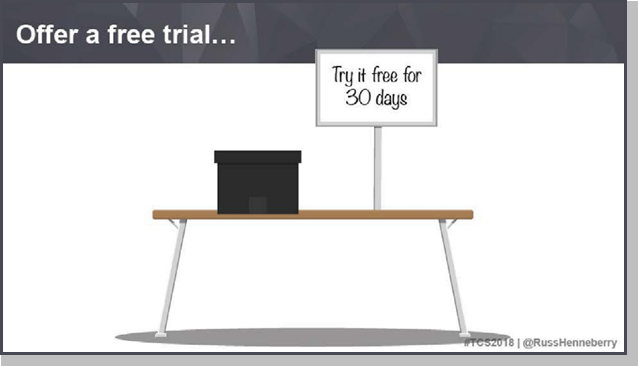
How about offering a trial to reverse risk? These are different way of putting offers on products. This is what we do all day long at DM. We’re constantly sitting around going like, “How should we position this offer?”
So, I’ll sit on a call with Richard or Ryan or somebody and I’ll be like, “So,
how’s that performing?”
“It’s not, like, it’s terrible. It shit the bed.” “Well, what are we going to do?”
“Well, I don’t know, I think we need to offer payment terms on this thing, I think the price point’s too high. Or, let’s try bundling it with this, and changing the copy to that.”
This is how we think, and this is how I’m trying to encourage you to think about your information products. Offer a free trial to reverse risk. Try it free for 30 days, that’s another thing you can add to a product to make the offer more compelling.
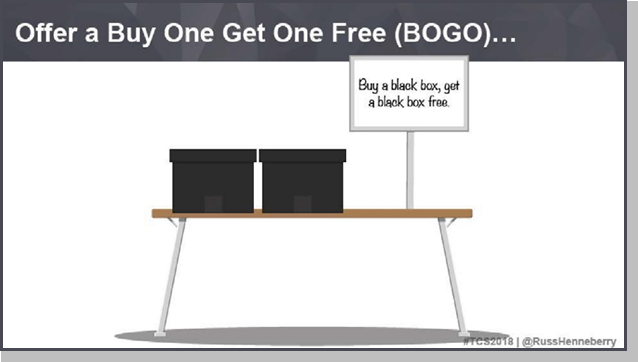
What about a BOGO, right? Buy one, get one free. Buy a black box, get a second black box free. We did this with our digital marketing mastery class that was live, right. You would wonder why anybody would want two of the same information product, right?
Why do I want two books? Same book. Same information in both books, but you can sell a course, for example, and say, you buy one and you bring a friend in free. We did this with our digital marketing mastery course and we sold 300 copies of that at $3,500 and ended up with 600 customers in that product. Because it was just a great offer.
Again, see what I’m saying? Great offer. The product was great, that’s sort of table stakes, you’ve gotta come into the game with a great product, but you could have a great product, have a really bad offer, and it’ll just not perform and you might go and take something that you put your blood, sweat, and tears into, and kill it without trying all these different things that you could try to sell that thing.
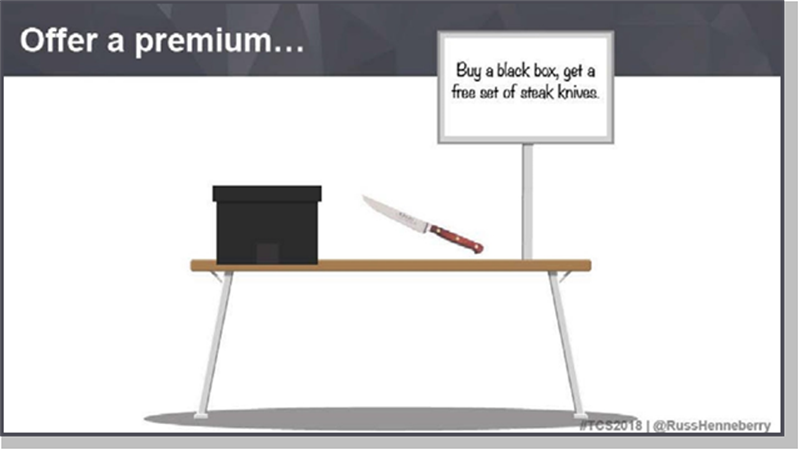
Try offering a premium. The banks do it all the time. Lots of people offer premiums. Buy a black box, get a free set of steak knives. Just
give them something for free. So, if you sell a fitness product, give me a pedometer. You’d be surprised what would happen to your sales if you add the right premium. It could be something that costs you pennies off of
Oriental Trading, and people will suddenly just start buying this product that never sold before.
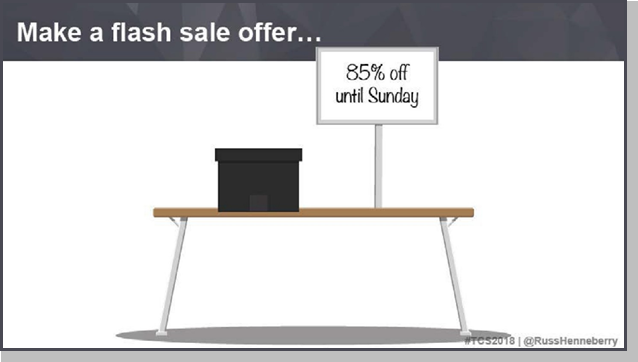
Make a flash sale offer. Take the same product that you have, that didn’t sell, or, honestly, if you’re in information, you should be consistently flash sale-ing. Once a month, once every two months, run a flash sale to activate lots of buyers.
Get lots of people to buy by taking something that you’ve already established the price point. Let’s say you’ve established a price point at $99. Offer it for
$27. You’ve gone out there and you’ve asked people to buy this thing for $99, you go out there and you offer it for $27 in a flash sale.
And what is a flash sale? A flash sale is an unbelievable discount for a limited time. It’s Groupon. The entire business was built on the back of flash sales.
85% off until Sunday. So offer a flash sale, take the same product that didn’t
do well, maybe, at the price, or did do well, who cares if it did well?
Maybe you feel like it’s worn out because you wear out your products, right? Run it on a flash sale. Three days, and the e-mails are super simple. Flash sale e-mails are great. “Hey, I’ve got this thing. It’s really, really deeply discounted, and this is what it does.” And then you start closing. The next two e-mails are just, “Hey, this goes away tomorrow. Hey, this goes away today.” And you’re done. That’s the whole e-mail series, right? Or ad series, whatever you’re using.
But, flash sales are unbelievably powerful. Here’s one that Michael Hyatt was
running. It’s not a super deep discount, but ten percent off, ends tonight.
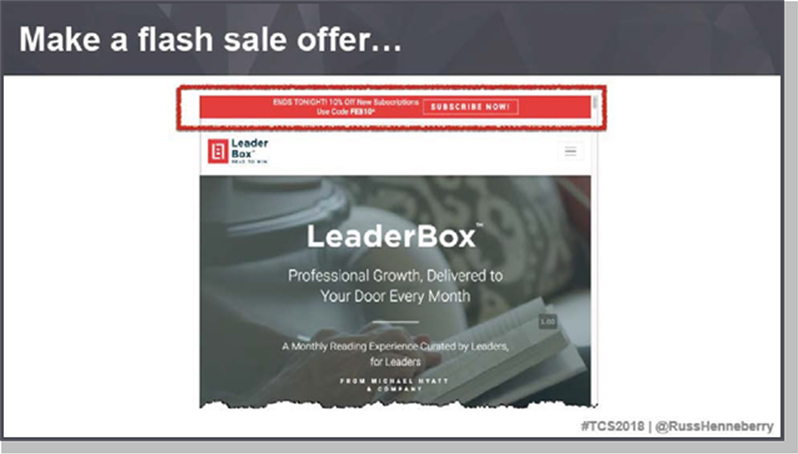
Nothing makes people move faster. You’ve got to tell them why. Why now? Because it’s on sale. Okay, but, so when’s the sale end? Tonight. Ooh, better grab that now!
You will be shocked at how, if you aren’t adding any scarcity to your offers, you should be very happy right now. Because, I’m telling you, add scarcity, you’ll have sales. You need to give them a reason that they need to act now. The price is going up, there’s a limited number of seats, right? Use scarcity.
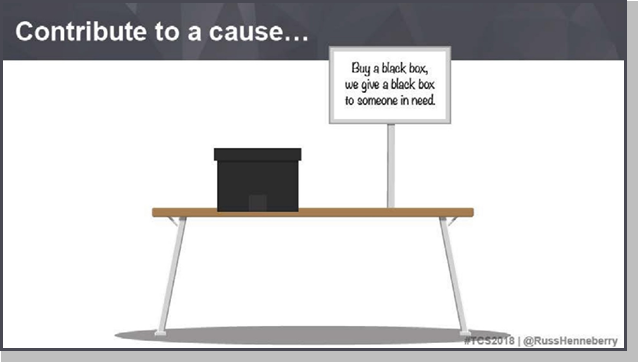
Believe it or not, contributing to a cause could be part of your offer. This is a relatively new concept. You guys have heard about the whole idea about
social business, right? The whole idea that the millennials especially are very interested in, “What’s your cause, man? What’s your mission? What are you trying to do?”
And it’s actually, if you think about it, it’s part of the offer. It’s part of the reason people buy. The reason that somebody would say, why do I want this black box. Well, because you buy a black box, and we give a black box to someone in need. We give scholarships. What could you do to add something to your offer that has a social component? Oh, and by the way, you’ll do some real good in the world, but I guarantee you’re going to see better sales, you’re going to see people that will align with what you’re doing.
Tom’s Shoes made this one of the most successful and well-known concepts. Think about this. This tag, that’s a massive amount of real estate for them to chow up and use the copy on this thing. When you buy a pair of shoes from Tom’s, we’ll give a pair of new shoes to a child in need. One for one. It’s part of the offer. It’s part of the reason people buy.
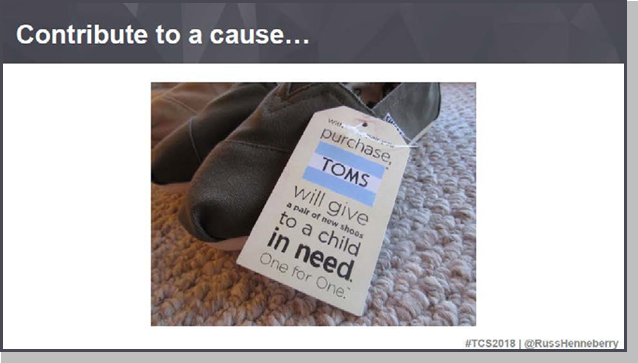
So, you can add a social component to your offer, and watch your sales go up. And, do some good, right? Do something good like help put shoes on people’s feet.
Don’t forget, if your products are not selling, stop crying in your beer and check your offer. Try the offer in multiple different ways before you ever give up.
We launched a product four years ago called Napkin Project. Anybody buy that? Nope. Because it didn’t sell. It sold like shit. But we tried it every which way from Sunday to sell it. We sold it this way, and that way, and this way, and that way, and we tried it this way, and we tried it with this, and we tried it with that, and we bundled it with that, and eventually, we sent it to the showers. You gotta go. Can’t sell ya. Just didn’t work.
That’s about the only product I can think of that we’ve ever launched that we ultimately didn’t find the right offer, the right way to position it, the right way to sell it.
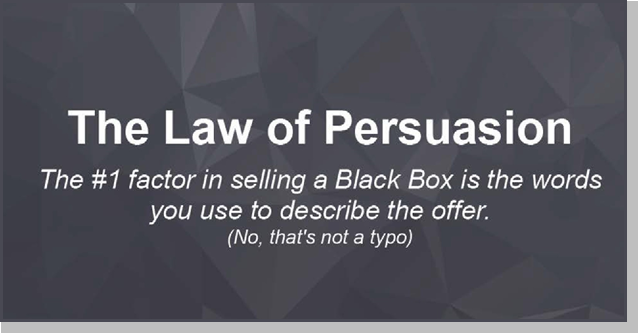
Because the second thing you need to understand is the law of persuasion.
The number one factor, and that’s not a typo, I know I said the number one factor was the offer, but the number one factor is the words you use to describe the offer.
When you’re selling a black box, something I can’t touch, kick, feel, try on, whatever, you’ve gotta use the right words to describe said black box. What’s in it, what does it do for me, right?
That’s not a typo. If your product is not selling, it’s probably not the product.
This is good news because you put a lot of blood, sweat, and tears into it, didn’t you? It’s probably not the product. It’s more likely the way you’re articulating the product and that offer.
So, the good news is, if you’ve got a product that’s not doing well, or you have a product that you’re getting ready to launch, think about the offer and think about the words you’re using to describe the offer. You must become better at copywriting, or find someone that is. So, words matter big time.
Quick plug for our Direct-Response Copywriting Specialist Certification. If
you’re not good at copywriting, take this class:
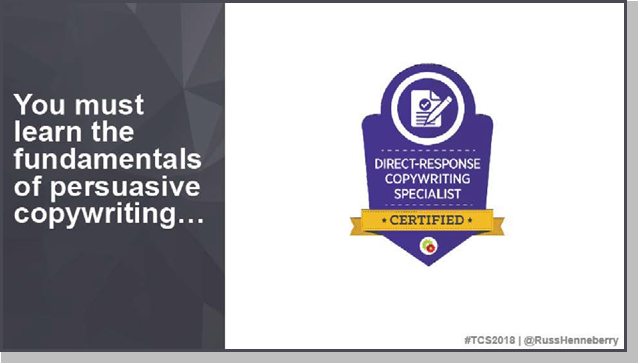
3 Areas of Copy to Focus On
Now, when you’re selling a black box, I need you to focus your effort on three areas of your sales copy, okay? Now, there’s a lot to be said about writing good copy, but if you miss these three things, when you’re selling black boxes, when you’re selling information, you’ll have a harder time selling.
You’ll see better results if you talk about these three areas.
It’s an easy acronym to remember: TAP. The first letter in there, T, is for transformation. This is just huge stuff, especially when you’re selling information because it’s so easy to see how you can work this into information. Some other products it’s a little bit harder, but when you’re selling information products, you’re going to instantly get this.

Watch this. You think about your product, and I want you to think about your potential prospect in this state of before. It’s not ideal, alright? What’s their problem, right? And then you have the person over here, they’ve got your black box. Look how happy that guy is.
Marketing is your ability to actually articulate this divide and how this is going to go. How are you going to move this person from here to here. It’s this transformation from before to after. If you can just grasp that, whatever it is you’re selling, what is the before state? Now, they’re over here. What’s the after state? Can you write about that? That’s copywriting.
That’s really solid. Use it in your e-mails, use it in your sales copy, use it in your VSLs, use it everywhere that you can think to use it, because all you’re really trying to do, especially when you’re selling information, is move somebody from this not ideal before state to this ideal after state.
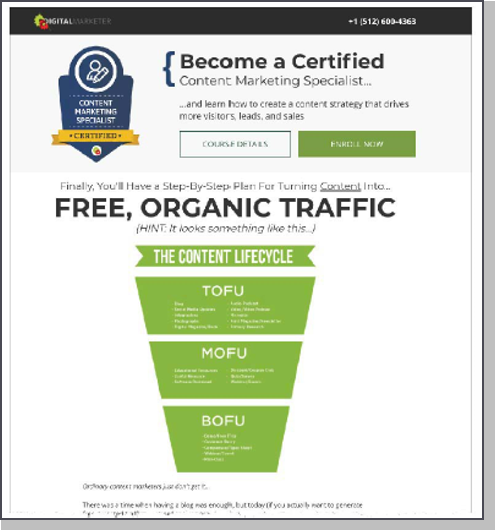
Let’s look at a product that we sell, and the copy- I wrote a lot of this copy, and I also produce the product, and so I’m very familiar with this copy, and let’s talk about how we use transformation to sell this product.
So, it’s called our content marketing specialist certification, and this is the
sales page.

Now, we start talking about the copy. First, start thinking about what will they have once they are in the after state that they don’t have in the before state. What will they have? Think about this for your product. What will they have? I’ll give you some examples…
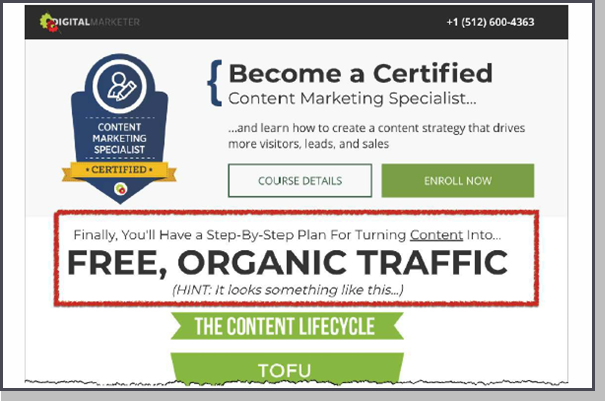
Look at this headline. Finally, you’ll have a step-by-step plan for turning content into free, organic traffic. Speak to what they will have in the after state, because the person reading this is in the before state. They don’t have a plan for turning content into free, organic traffic.
You could steal that headline and put it on the front of your sales page, probably not that same one, but you know, change it a little bit to fit what you sell, but you see. Talk to what they’ll have in the after state, and you’ll sell more product. Because you’re speaking to them in words they understand.
I’m in pain over here. I’m in pain, and now I’m not in pain. I got your black box. What happened here, right? What did I get? You got a plan for turning content into free, organic traffic.

Quick tip when you’re trying to sell a black box to somebody, because it’s so, again, it’s like selling air, right? Use a metaphor or a simile. I’ll give you an example:
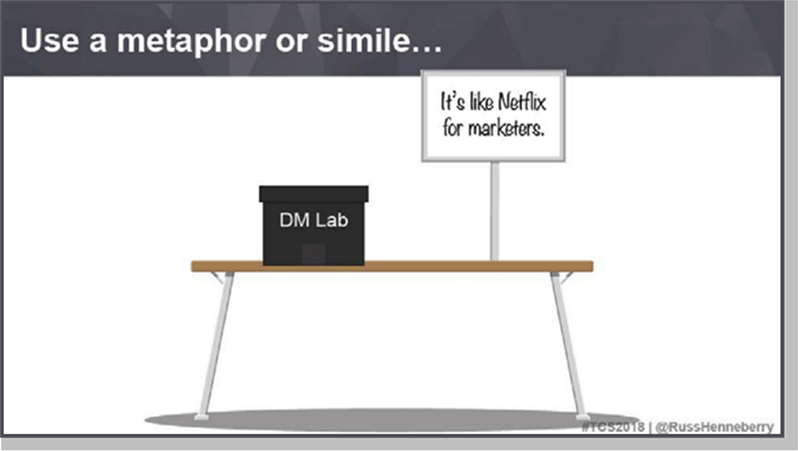
DM Lab is a whole bunch of content, and community and all this stuff around
digital marketing. We sell this by saying it’s like Netflix for marketers. Instantly you get it, don’t you? You’re like, “Ooh, It’s like Netflix for marketers, I get that.”
When you’re selling things that are difficult to describe or that are complex, the choice of metaphor is important. We spent a lot of time, and once we finally landed on that, we were like, I think that’s it. And that was our headline for a long time, Netflix for marketers.
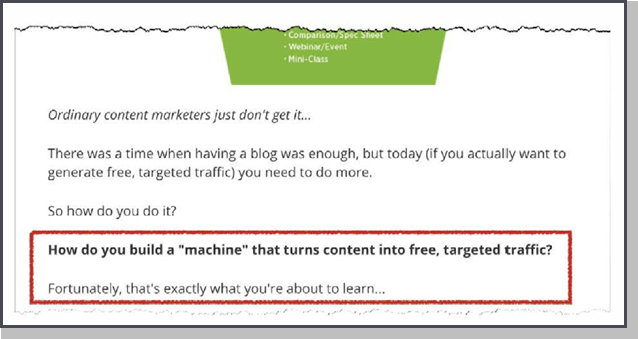
Look at this metaphor: How do you build a machine that turns content into free, targeted content? So, machine is the metaphor here. Can you describe this thing that they’re going to get? Well, yeah, it’s a machine that does this. Oh, a machine, I understand what a machine is, it’s something that does stuff automatically. I turn it on and it goes, right? I can walk away, and then I come back, stuff’s happened.

Speak to the prospect’s status. Man, when you’re selling information products, speak to status. This is one of the reasons people buy things, is to elevate their status. I’m going to like walk up here, I’ve been creeping up a little bit at a time, and I think I’m going to go for it. So, you speak to the prospect’s status because people buy status. It’s one of the most important reasons people buy things.
Let me show you an example of this in action in our copy here:
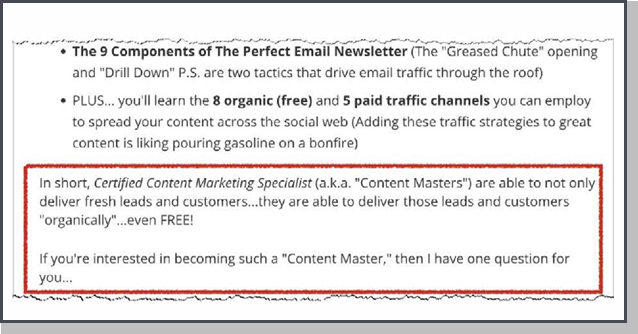
This is me selling the content marketing certification. In short, certified content marketing specialists, a.k.a. content masters, are able to blah, blah blah. You see how that elevates their status? They’re a content master now. In the before state, they’re a loser. In the after state, you’re a content master.
What do you sell? And, how does what you give them elevate their status?
Do they go from being bad dad to super dad? Do they go from being out
of shape and no energy and everything to super fit? And, you know, how are
you going to describe the raise in status?
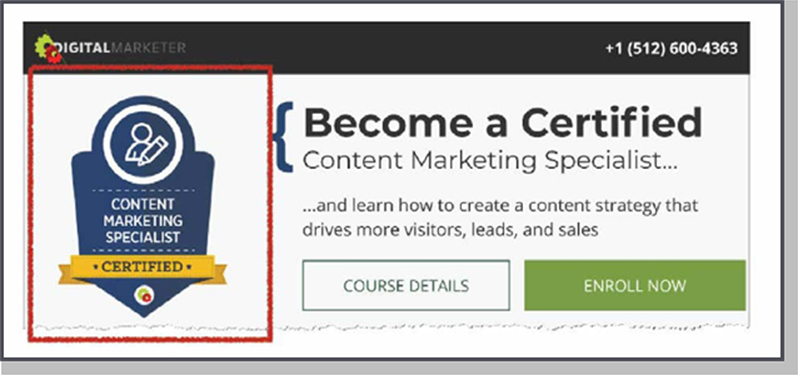
I mean, if you think about, this entire idea of us giving you a certification is an elevation of status. That badge right there, how do we distinguish people’s status in the military? We give them badges and stripes and different things like that. The idea of giving somebody, and actually paying a good graphic designer to create nice looking, this is an elevation of status.
And you might be out there thinking like, that’s B.S. That’s a graphic. But it’s not to a lot of people. A lot of people are like, I can tell you this right now. Over and over again in our Facebook groups, people post these things and they say, I got my thing. I’m a content marketing specialist now. They put them in the side bar of their web sites, they put them in their e-mails.
It’s status, guys, and if you can figure out, and there’s lots of different ways to tell somebody you’re going to have a higher status when you come through, from the before state to the after state.
Chandler Bolt sells information about how to write a book. Is there anything more status elevating than writing a book? Can you speak to that status? And I know he does in his copy. This is a super smart marketer, right? Before State, well you’re kind of not published, and you’re not recognized as an authority.
In the After State, you’re an author, right? You are now an author. That’s status.
Think about that, think about how it applies to what you do. Think about what Napoleon said here:
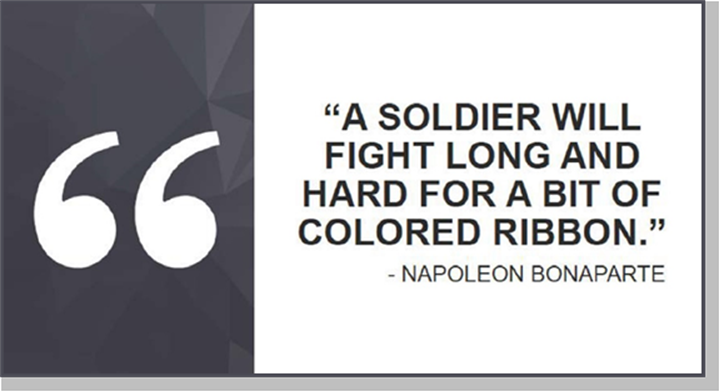
It’s kind of evil, actually. It’s a little manipulative, but he’s right. People are motivated, whether you like it or not, you are motivated by elevations of status, and you need to understand that to sell information products, because there’s nothing that sells better, except for scarcity and urgency and things like that, than to speak to someone about their Before, their After, tell ‘em what they’ll have, and tell them how their status will be changed.
The next letter, A, is for authority. You can’t sell me something unless I think you can help me. And so, you need to prove that you can help me. You need to establish your authority.
Here’s how we did it here:
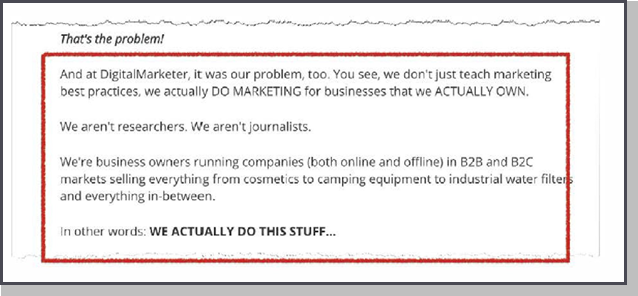
At DigitalMarketer, it was our problem, too. You see, we don’t just teach marketing best practices, we actually do marketing for businesses that we actually own. We aren’t researchers, we aren’t journalists. We’re business owners running companies, online and offline, and in B2B and B2C, you can see where we’re going here. We’re bad asses. Establish your authority in your copy. Why should you teach me this? Sometimes you don’t have this, right?
You’re like, well, I don’t know.
But most of the time when somebody feels like they don’t have that, it’s because of the fact that the reason they’re really selling what they’re selling is because it happened to them, right? I was able to move myself from before to after, and I’m going to teach you how I did it. That’s a great story, actually. It’s one of the most powerful stories in the world. It’s called the hero’s journey.
How did you go from hell to heaven and slay the dragons in between? And the thing that you’re selling is the in between part. How I got there, how did I do it? If you have that story, tell it and it builds authority.
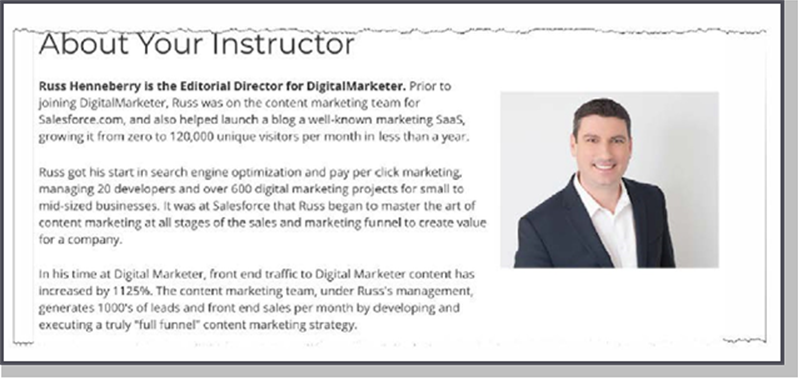
We do things like put the About the Instructor page on here with my awesome game show host headshot. Doesn’t it look like I’m on Let’s Make a Deal or something?
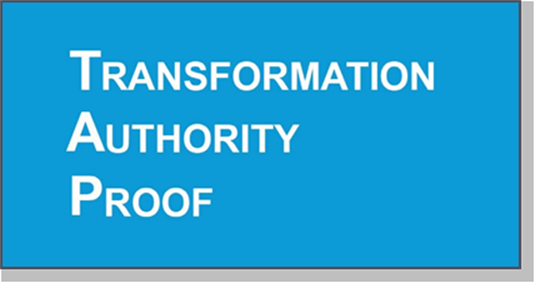
So, lastly, P, is for Proof. You can take me through a transformation. It’s, what’s the transformation, why do you have the authority to actually take me through this transformation, and where’s the proof that you’ve done it before?
If you don’t have these three elements in your e-mails and in your VSLs and in your different things, you’re going to have a hard time because people are going to have questions when they’re done. They’re going to be like well, yeah, you described the transformation, I get it. You seem to have the authority, but I don’t see any proof.
And it’s as simple as, you may not have this at the beginning when you launch, but as soon as you can, get some good testimonials on there. And, by the way, extra bonus points if your testimonials talk about the transformation that the person went through.
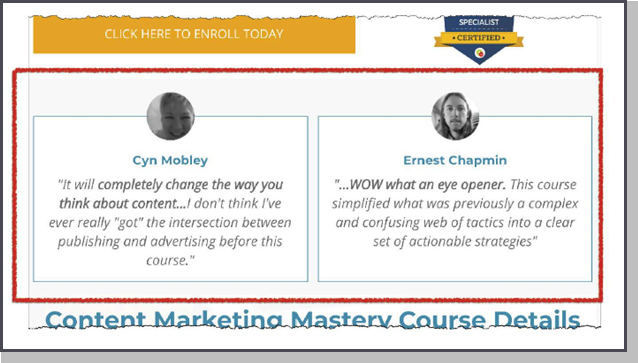
Actually, literally, the words say, you know, think about what Cyn Mobley says here: “It will completely change the way you think about content.” So, she’s describing her transformation from before to after.
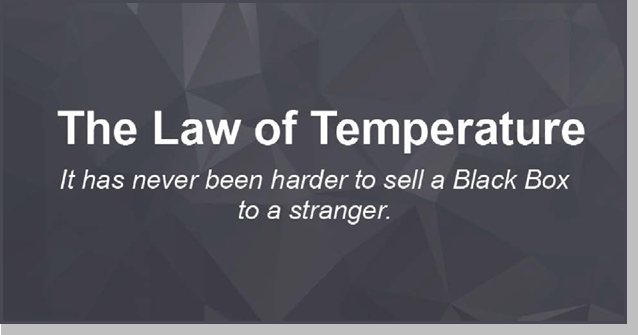
Law number four. The law of temperature. It’s never been harder to sell a black box to a stranger. We are so jaded, and sort of on our heels, when we’re on the web especially, it’s gotten really pretty hard to sell black boxes to strangers.
You know, guys that look like Jack Nicholson at the end of The Shining. The trouble with cold prospects is that they are frightened of you. They don’t know you, and they’ve never purchased anything from you before. They don’t know that you can take them through the transformation that you’re promising.
But the upside is that there’s a lot of ‘em. There are so many cold prospects. The vast majority of the people on the planet that are a good fit for your product will never know your product exists. That’s why there’s so many cold prospects out there, and you have to deal with this problem.
The most difficult and expensive activity your business is going to undertake, besides hiring employees and dealing with that sort of stuff, is customer acquisition. How will you acquire customers. It’s the most
important, it’s the most expensive, and if you can solve this problem, you can sell black boxes left and right.
I’m going to show you how we do it. We reduce risk, simple as that. You don’t know me, bro, I’m selling black boxes. I know, it’s kind of weird. Don’t run away, I’m going to reduce the risk down for you. I’m going to make this real easy for you to dip your toes in the water and just check us out, right?
Now this is one reason why your content strategy is critical. Is your blog there for people to at least find a few articles where they can go, “Huh, this guy’s pretty smart.” Do you have a podcast, or anything at the very top of the funnel that allows people to kind of mill around for free and check out what you’re doing?
So, if you’re selling black boxes to people, and you want to allow them to dip their toe in the water, but you want to make an offer, you want to actually sell them something, here’s how you do it, and this is what we do all day long at DigitalMarketer.

We splinter. You splinter a product out of your larger, more expensive, more risky, more scary product and you make that offer to cold traffic. People that look like Jack Nicholson that don’t know who you are and are frightened of you a little bit, and they want to dip their toes in the water. It looks like this:
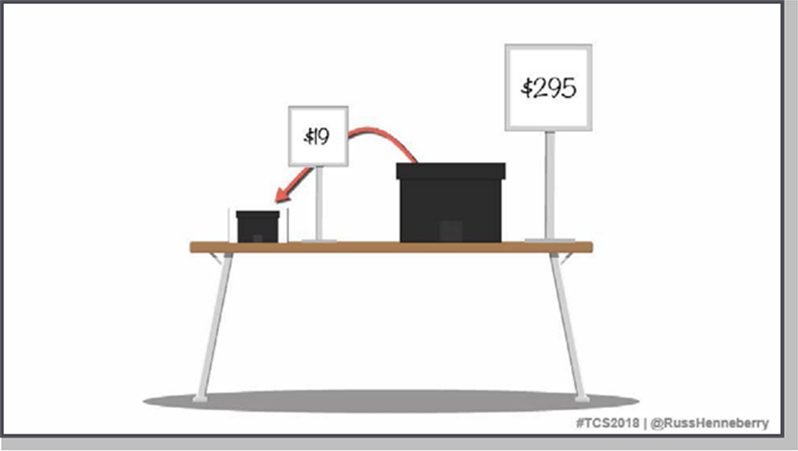
You’ve got a $295 big old black box. The customer may be thinking, “I’m scared to give you $295. I don’t care if you tell me you’ve got a 60-day return policy and that it’s an ironclad guarantee. I don’t wanna give you $295, dude. I don’t know you. Who are you?”
So what you do is, you take this big old black box and you pluck a little piece out of it, and this is so easy to do in information products. This is for the people who have never bought from you before. The vast majority of you in here started your trek with DigitalMarketer by buying a $7 product. The vast majority of you. And now you’re at T&C, a very risky offer, isn’t it? Fly to San Diego, give us $495, or all the way up to whatever we closed the price at, that’s a risky offer, right? And it started, for most of you, with just give us
$7, and we can prove to you that we’re good.
So you splinter. You know, maybe you make that offer at $19. This is why books, by the way, make great front ends. Because this is about the price of a book. Let’s look at what Tony Robbins does here:
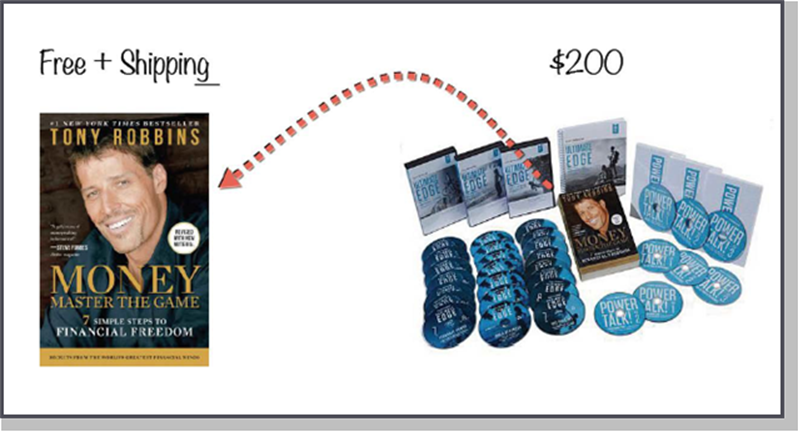
Money, master the game. Really well selling product. It’s sold at a lot of different price points because Tony’s smart and makes lots of different offers. He bundles it, he does this, he throws it in over here. But it usually sells for around $200. Right here in the middle of his product, this is the whole product, this is the big kahuna. Jack Nicholson don’t wanna buy that if he doesn’t know Tony. Everybody knows Tony, but you get the point. You know, the cold audience doesn’t want to buy this thing, it’s too risky. You take and you splinter out the book for free plus shipping, and there you go.
Now I’ve got a super low risk, dip your toes in the water offer for Jack Nicholson.
The biggest and most expensive thing you’re going to overcome as an information product seller is customer acquisition. You’ve gotta learn so you can make it so you can scale up that customer acquisition. Of course, some cold audiences, some people will buy your $200 thing, they’ll be like, well, screw it. These are the people that are just like, look, I have a high trust of other people. I’ll buy your $200 thing. Most people won’t, and so you need to develop front end offers like this one.
And the easiest way to do it in information, and by the way, if you’re looking to get started, especially building courses, build the big one first. Build the big boy and then splinter something out of it, out to the front. You start with the big guy, and then you can splinter different things out, like, what if this didn’t work? This front end doesn’t work to sell this product.
He can’t move this book for whatever reason, the headline sucks, whatever, he can’t sell it. You think he’s going to quit? No way. He believes in this product. It’s not the product, it was the offer. Change that front end and try something else. You know, splinter out one of these power talks, or bundle a bunch of these power talks together and pop that out on the front end and see if that works. Don’t give up on these products, change the offers on the front end to see if you can get it to work.

We do the same thing to sell DigitalMarketer Lab, a membership site. DigitalMarketer Lab is like, remember, it’s like Netflix for marketers, my metaphor thing. It’s a whole bunch of different execution plans and here’s one right here called The Content Engine that I made, and we’ll go and we’ll pull that little sucker out, and put it out on the front end for $27. Super low risk, and you dip your toes in the water and try DigitalMarketer’s products.
That’s how you sell information to people that don’t know who you are, you give them super low risk. They get started listening to your podcast, watching your YouTube videos, and you’re like, I don’t know how I’ll ever make money
from this stuff. I just keep doing this podcast, and nobody ever buys my
$784,000 product. It’s bullshit.
You’ve gotta understand that even people who listen to your podcast for 100 episodes may not wanna buy your $784,000 highly complex, highly hard to understand product. They wanna buy something simple. Like, “Hey, you wanna learn how to quickly crank out share worthy, clickable blog content?
Yeah? Alright, give me $20.” That’s super low risk, and you need something like that on the front end.
You know, like where’s the money get made? I can’t make a living selling $27 things. The money doesn’t get made here. This is all about, what did I say?
The most expensive, difficult, and important thing you’re going to figure out, if you’re going to sell information, at any level, is customer acquisition and the money does not get made here. The money gets made on the back end.
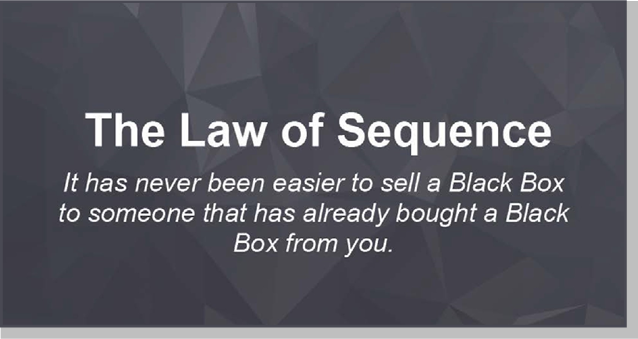
So, the law of sequence is the fifth law. It’s never been easier to sell a black box to someone that has already bought a black box. So while it’s never been harder to sell a black box to someone who’s never bought a black box from you before, it’s never been easier to make the second sale. Again, my disclaimer, you have great products.

Look at this, you’ve got these super, we call them hot prospects, or we call this type of audience hot. We use this word all the time internally at DM, and we’re not the ones that coined it. If you talk to any marketers in the know, they’re going to say cold and hot, cold and hot, right? They’re going to talk about cold audiences, they’re going to talk about hot or warm audiences.
For me, the warmest you can get is somebody that’s bought from you. So the great thing about hot prospects, look at this guy. He’s got your $9 black box, he’s got your front end offer. He was cold, he bought your whatever and he’s all happy. And he’s looking at this $295 going, well, you didn’t screw me over here, now I’ll buy this. This is how you sell black boxes to people that have never bought them before, because this guy’s already purchased this sort of low risk, $9 product.

The problem with hot prospects is there’s not enough of them. The upside to cold traffic and cold audiences is that there’s almost an unending supply. The trouble with hot prospects is that there is an absolutely limited supply. You cannot create more customers.
Like, right now, you have X number of customers, and you’re going to get more, hopefully, but you can’t significantly change how many hot prospects you have. But the easiest way to get more hot prospects is to sell them something on the front end that’s a little bit low risk. Something cheaper.
So, you must, must, must, if you’re going to play this game, you must learn to both acquire customers, and then monetize the customers that you get.
You know, that old adage that it’s always cheaper to sell to the customers that you have is absolutely true. The problem is, when you’re in a growth mode and you wanna get bigger, you’re always like, we’ve gotta go out and get more customers. But please don’t forget that you have customers, and you should sell them more.

How do you do that? How do I monetize customers? Well, definitely look at continuity. If you’re in information, or you’re thinking about getting into it, and you don’t have some kind of continuity, or you’re not thinking about it at all, you might wanna think about it.
Continuity, or, in other words, getting somebody to start giving you money every month, every month or every year, that’s where it’s at. But it’s really expensive to get these kind of customers. It’s expensive to acquire these kinds of customers. But, if you’re up and you’re running and you’re rolling along and you’re selling, start thinking about how you’re going to add continuity like a membership site.
You know, Lab’s a beast we must keep feeding because it’s a continuity product. Why do you keep paying me month over month over month, it’s because we keep adding stuff to it. We keep doing stuff to it, so it becomes this bonfire that you must keep feeding.
But, my goodness, it’s really nice to know that next month we’re going to bill a certain amount of money, rather than trying to run on this launch schedule, always hunting. Every month you’re like, how am I going to make any money this month? We got to build something new, or do a launch or what are we going to do?
When you get continuity it smooths out your revenue, and it makes you feel much better from month to month because you’re like, okay, we know we have this coming in, right? Especially when you start getting employees, and you’ve gotta make payroll and you’re like, well, hopefully we sell some stuff next month. But when you’re on continuity, you know your churn rate, and you know about what you’re going to get coming in the next month.
Add an event. If you’re in information, a very, very close cousin to information is the event. This really is an information product in and of itself. And events can be very, very lucrative. This event, while it cost about
$2 million to put this event on, it also sells a lot of tickets. There’s a lot of you here. It’s a high-ticket item, and it’s a huge revenue driver for us and something that we can count on making big revenue hits when we promote Traffic & Conversion Summit.
But the one I love more than anything, especially if you’re just getting started, or you’re struggling a little bit at all, or if you just wanna make some big revenue pops, and again, there’s going to be an upside and a downside to this, is to add a high dollar, done-for-you service on the back end of any information product.
Whether it’s a book – I try to sell books so that I can sell you my done-for-you service. That’s it, that’s my whole model. My whole business model is, I go out there, I sell books to cold traffic, and then I follow up and try to get them to hire me as a service, right? That’s a business model that a lot of people are using. So, add a high dollar, done-for-you service on the back of a very low dollar, front end information product like a book or a little course or something.
What’s the downside? Well, now you’ve gotta do some work, or you’ve gotta hire somebody to do it, but you’ve gotta do the work. You’ve gotta do the service now. But because you are giving the customer your time, you wanna sell this for about 10-100 times the amount of that front-end information product.
It’s a high ticket, nice revenue hit, right, when you can go and sell a book for
$20, and then you follow up with e-mail, you try to sell them a service that’s 20 grand. That’s doable. Take them from a book, to a webinar, to a
$20,000 service. And just use information products as your front end. Books and info products go really, really well together.
Here’s an email that you can use:
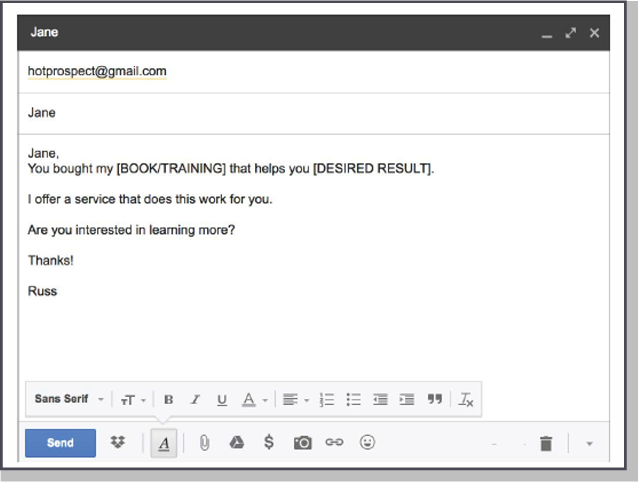
Send your existing customers this e-mail. Don’t send it through Aweber or MailChimp or anything. Get your, open Gmail and send this e-mail. The subject line is their first name. Jane. And say, Jane, you bought my book, or training, or whatever, that helps you get this desired result. Grow big, luscious, red tomatoes, lose ten pounds, learn to grow your blog, whatever that desired result is, there on the right. Jane, you bought my book or training that helps you do this. Did you know I offer a service that does
this for you. Are you interested in learning more? That’s it. Send that to ten customers, I bet you get a new service customer tomorrow. You’ll have a phone call at least.
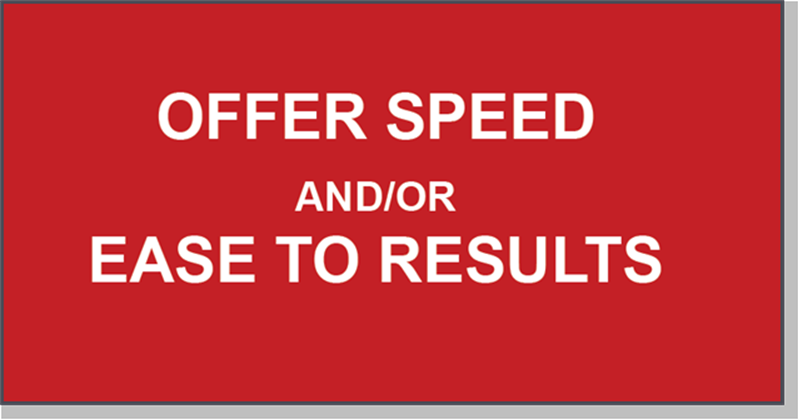
What are we selling here? When you go to sell service on the back of an information product, you want to offer speed or ease of results. That’s what you’re talking to them about. You’re talking to them about, hey, you wanted to learn how to grow big, red, luscious tomatoes. Do you know that I can come over to your house and do this for you and get you results faster or easier.
Fast and easy, that’s what everybody wants. They want things to be done faster, everybody’s in a hurry. So offer speed, or ease. So, you can use this:

David. You bought our golf training that’ll give you an extra 15 yards on your drive. I offer in person and virtual one-on-one coaching that will get you results quicker and easier. You interested? That’s the whole e-mail. And send it personally to 100 customers, and see if you can get that person to start paying you, what can you charge for golf lessons these days? Let’s say, $195 a month. You start getting them into a continuity service, something like that.
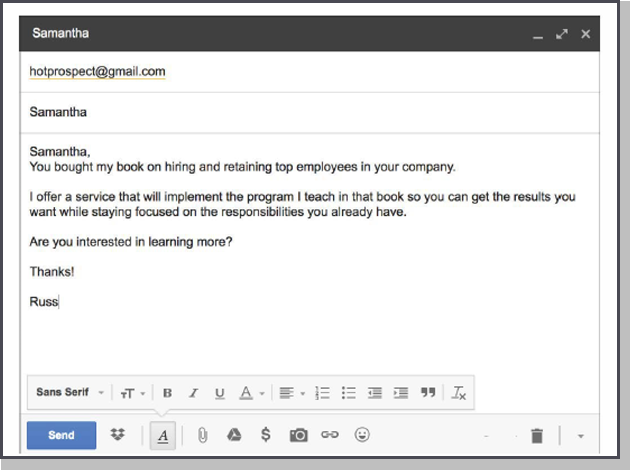
One more. This is a more B2B style. Samantha, you bought my book on hiring and retaining top employees in your company. I offer a service – remember, speed and ease of results. How fast can I get you this.
Tony Robbins uses this language a lot, he’ll say, “For those of you that don’t wanna dabble.” Because remember, you don’t wanna tell them that the book was crap that they bought, or that the course was crap, and now they need to hire you. It’s like, well, what happened? I thought I made a good decision. It’s like, no, no, no.
So Tony, somebody bought a book, right? He’ll email them or use video or something like that, and he’ll say, “For those of you that, you know, you just bought my book, and it’s great. You’re going to love it. But, for those of you that are super serious, and don’t wanna dabble, you should buy this.” And it’s much higher ticket, right? So it’s the same sort of thing, where you’re like, you bought the book, but did you know that I offer a service that will implement this program that I teach so you can get those results that you want while staying focused on your responsibilities? Are you interested?
This is a real easy way to sell services, super high ticket stuff, on the back end of a good information product and get super big revenue hits that pay the bills and that, I mean, obviously, now you’ve gotta go now and do some
consulting. So, you’ve gotta execute, but, man, if you’re struggling a little bit. Let me just leave you with a couple of things:
- Please don’t kill products until you’ve checked the offer and the
- Please don’t try to run your information business by selling high ticket, risky stuff to people that don’t know who you
- Learn to monetize the customers that you do get by offering them much higher ticket stuff like an event, a continuity site, or a really high-ticket, done-for-you service.
